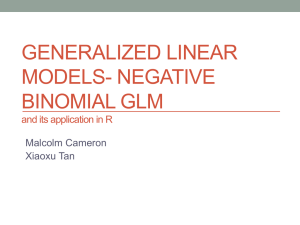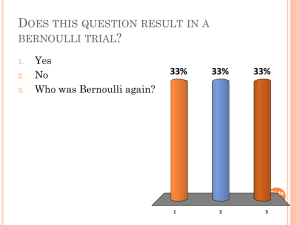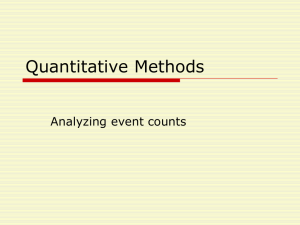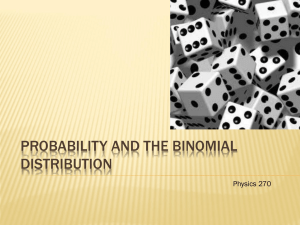一般化線形モデル generalized linear Models
advertisement
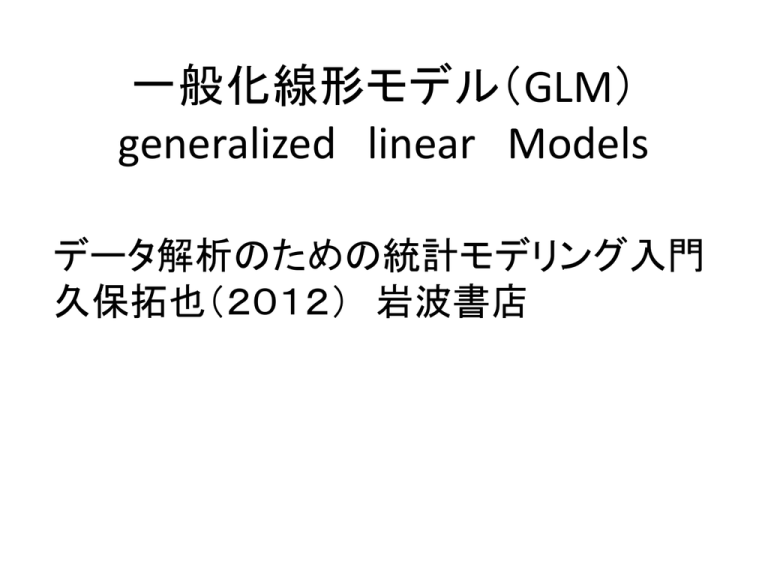
一般化線形モデル(GLM) generalized linear Models データ解析のための統計モデリング入門 久保拓也(2012) 岩波書店 Generalized Linear Models • Linear Model y i 1 2 xi 3 f i response variable ~ intercept + slope * explanatory variable lm(y~ x + f ・・・),lm(y~x + f -1) (no intercept) require(graphics) ## Annette Dobson (1990) "An Introduction to Generalized Linear Models". ## Page 9: Plant Weight Data. ctl <- c(4.17,5.58,5.18,6.11,4.50,4.61,5.17,4.53,5.33,5.14) trt <- c(4.81,4.17,4.41,3.59,5.87,3.83,6.03,4.89,4.32,4.69) group <- gl(2,10,20, labels=c("Ctl","Trt")) weight <- c(ctl, trt) lm.D9 <- lm(weight ~ group) lm.D90 <- lm(weight ~ group - 1) # omitting intercept anova(lm.D9) summary(lm.D90) opar <- par(mfrow = c(2,2), oma = c(0, 0, 1.1, 0)) plot(lm.D9, las = 1) # Residuals, Fitted, ... Par(opar) Generalized Linear Models • Linear Model y i 1 2 xi 3 f i response variable ~ intercept + slope * explanatory variable lm(y~ x + f ・・・),lm(y~x + f -1) (no intercept) Generalized Linear Model f ( y i ) 1 2 xi 3 f i Model &Link function ~ intercept + slope * explanatory variable glm(y ~ x, data = d, family = poisson) Poisson Model (counting data of occurrence) Poisson Model exp( ) y p( y | ) E ( y) y! λ:mean occurrence in unit time yp ( y ) y0 Identity link i 1 2 x i 3 f i Log link(canonical) log( i ) 1 2 x i 3 f i i exp( 1 ) exp( 2 x i ) exp( 3 f i ) 正準リンク関数:最も自然なリンク関数:乗法効果) Link function ~ intercept + slope * explanatory variable glm(y ~ x, data = d, family = poisson(link=“log”)) Canonical link function is set as default Poisson Model (p49) (counting data of occurrence) Poisson Model for number of seeds of a plant, regressed on plant size and nutrification (p49) Maximize log-likelihood y log L ( 1 , 2 , 3 ) log i i exp( i ) i yi! log( i ) 1 2 x i 3 f i glm(y ~ x + f, data = d, family = poisson) #page 42 plant data d <- read.csv("data3a.csv") d$y # number of seeds d$x # plant size (hight) d$f # nutrification (treat-control) plot(d$x, d$y, pch =c(21, 19)[d$f]) # model p58 fit.all <- glm(y ~ x + f, data=d, family=poisson) print(fit.all) logLik(fit.all) plot(d$x, d$y, pch =c(21, 19)[d$f]) xx <- seq(min(d$x), max(d$x), length =100) lines(xx,exp(1.263 + 0.0801 * xx), lwd=2) Poisson Model (p49) (counting data of occurrence) log( i ) 1 2 x i 3 f i 6 yi! 4 i 2 log yi d$y log L ( 1 , 2 , 3 ) i exp( i ) 8 10 14 Poisson Model for number of seeds of a plant, regressed on plant size and nutrification (p49) Maximize log-likelihood 7 #page 42 plant data d <- read.csv("data3a.csv") d$y # number of seeds d$x # plant size (hight) d$f # nutrification (treat-control) plot(d$x, d$y, pch =c(21, 19)[d$f]) 8 9 10 11 12 # model p58 d$x fit.all <- glm(y ~ x + f, data=d, family=poisson) print(fit.all) logLik(fit.all) plot(d$x, d$y, pch =c(21, 19)[d$f]) xx <- seq(min(d$x), max(d$x), length =100) lines(xx,exp(1.263 + 0.0801 * xx), lwd=2) Other Generalized Linear Models (chap6 p114) (discrete) (continuous) Probability Random numbers generation Family in glm() Standard link function Binomial rbinom() binomial logit Poisson rpois() poisson log Negative Binomial rnbinom() (glb.nb() function) log Gamma rgamma() gamma log, inverse Normal rnorm() gaussian identity Generalized Linear Models Generalized Linear Model f ( y i ) 1 2 xi 3 f i glm(y ~ x, data = d, family = poisson) Family (Modelled Probability Distribution) binomial(link = “logit“) 2項分布(規定試行中の発生数) gaussian(link = “identity”) 正規分布 Gamma(link = “inverse”) ガンマ分布(正のみ) inverse.gaussian(link = “1/mu^2”) 逆ガウス分布 poisson(link = “log”) ポアソン分布(一定時間中の発生回数) quasi(link = “identity”, variance = “constant”)正規分布(不均一) quasibinomial(link = “logit”) 2項分布(分散不均一) quasipoisson(link = “log”) ポアソン分布(分散不均一) Binomial Logistic Model (p118) (occurrence number in given trials) Binomial Model for the number of survived plant in 8 obserbations, regressed on plant size and nutrification (p118) 1 Maximize log-likelihood q i logitstic ( z i ) N p ( y | N , q ) y y Ny q (1 q ) 1 exp( z i ) z i log qi 1 qi glm(cbind(y,N-y) ~ x + f, data = d, family = binomial) #page 117 plant data d <- read.csv("data4a.csv") d$N # number of trials d$y # number of survived plant d$x # plant size d$f # nutrification (treat-control) # model p122 fit.all <- glm(cbind(y, N-y) ~ x + f, data=d, family=binomi print(fit.all) logLik(fit.all) Offset Term(p131) (avoid a division calculation) Count data for several zones having different area, or different population One way is define a density (occurrence in unit area) and apply Poisson model A exp( x ) log L ( 1 , 2 , 3 ) log i i exp( i ) yi yi! i i 1 2 i log( i ) 1 2 x i log Ai glm(y ~ x, offset =log(A), data = d, family = poisson) #page 133 plant data d <- read.csv("data4b.csv") d$y # number of plants in lot i d$x # brightness at lot I d$A # area of lot i plot(d$A, d$y) # model p131 fit<- glm(y ~ x, offset = log(A) , data=d, family=poisson) print(fit) logLik(fit) Gamma Distribution Model (p138) Gamma Distribution (continuous positive data) P ( y | s, r ) r s y s 1 exp( ry ) y s 1 y ) s: shape parameter, r: rate parameter, theta=1/r: scale parameter time length before s times occurrence of random events with occurrence rate of r. (average occurrence interval is 1 / r ) Average : s / r s Variance: s / r 2 s 2 (s) ( s ) exp( s dgamma(y, shape, rate) Weight of flower of a plant y (continuous, positive) average weight Ax exp( a ) x exp( a b log x ) Loglink function of linear estimator log( i ) a b log i b i b i i glm(y ~ log(x), data = d, family = gamma(link="log")) xi Gamma Distribution Model (p138) Gamma Distribution (continuous positive data) glm(y ~ log(x), data = d, family = gamma(link="log") # A Gamma example, from McCullagh & Nelder (1989, pp. 300-2) clotting <- data.frame( u = c(5,10,15,20,30,40,60,80,100), lot1 = c(118,58,42,35,27,25,21,19,18), lot2 = c(69,35,26,21,18,16,13,12,12)) summary(glm(lot1 ~ log(u), data=clotting, family=Gamma)) summary(glm(lot2 ~ log(u), data=clotting, family=Gamma)) Call:glm(formula = lot1 ~ log(u), family = Gamma, data = clotting) Deviance Residuals: Min 1Q Median 3Q Max -0.04008 -0.03756 -0.02637 0.02905 0.08641 Coefficients: Estimate Std. Error t value Pr(>|t|) (Intercept) -0.0165544 0.0009275 -17.85 4.28e-07 *** log(u) 0.0153431 0.0004150 36.98 2.75e-09 *** ---

